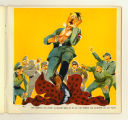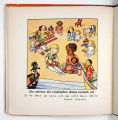 |
BABY'S PRIMER. Illustrated by Morgan J Sweeney. Boston: D. Lothrop Co., 1879. Printed by Deland and Barta.
Relief illustrations printed on linen, uncolored. This book has several images of the character Topsey, made famous by UNCLE TOM'S CABIN. Exhibit checklist 20.1 (View this item) |
 |
THE GOSPEL OF SLAVERY: A PRIMER OF FREEDOM. By Iron Gray [Abel Charles Thomas]. New York: T.W. Strong, 1864.
Woodcut illustrations, uncolored. Exhibit checklist 20.2 (View this item) |
 |
DEN ONDE FYRSTE: EVENTYR FOR BORN OG VOKSNE. FORORD OG MORAL AF AAGE HERMANN. By H. C. Andersen. Kobenhavn: Alex. Vincent, 1940.
Lithograph illustrations, color printed by Palle Wennerwald. A rewrite of Hans Christian Andersen's 1840 story of "The Wicked Prince" where a tyrant is struck down by a little fly. Here the tyrant is Hitler. Exhibit checklist 20.3 (View this item) |
 |
ENGLISH STRUWWELPETER OR PRETTY STORIES & FUNNY PICTURES FOR LITTLE CHILDREN. By Dr. Heinrich Hoffmann. Frankfurt: Rutten & Loening, [1875]. Sixtieth edition.
Relief prints, color printed. In "The Story of the Inky Boys," three little white boys make fun of a "black-a-moor." Agrippa, shown in a long robe, gets angry and tells the boys to leave the man alone. They laugh and Agrippa dips the boys in ink making them black as well. "The black-a-moor enjoys the fun...the silly inky boys! Because they set up such a roar, And teas'd the harmless black-a-moor." Innovative thinking for the 1870s. Exhibit checklist 20.5 (View this item) |
 |
MY HONEY'S ABC. London, Paris, New York: Raphael Tuck & Sons, Ltd, 1900.
Cloth with dye colored illustrations, some signed "B". Labeled "Father Tuck's Indestructible Calico Book." Exhibit checklist 20.6 (View this item) |
 |
EINE WAHRE GESCHICHTE; WORTE UND FILDER VON ZWEI DEUTSCHEN AUS DEM AUSLANDE. Stuttgard: Franckh'sche verlagshandlung [c. 1936].
Lithographic illustrations, color printed. This is a laudatory biography of Adolf Hitler for German children. Exhibit checklist 20.8 (View this item) |
 |
THE A TO Z BOOK. By Peter Mabie [Emilie Agnes Wiedenbeck]. Racine, WI: Whitman Pub. Co., 1929.
Lithograph illustrations, color printed. Racial, ethnic and social stereotypes were common in children's books until the late 1960's or early 1970's but can probably still be found. Inside a Native American is shown under "I" for Indian and a figure is shown under "J" who is probably intended to be Japanese but is very stereotypically Chinese and appears to have been the model for the standard Asian characters in movies. Exhibit checklist 20.9 (View this item) |
 |
MY PICTURE BOOK. New York: American Tract Society, n. d.
Wood engraved illustrations, uncolored. Includes a passage about "The Heathen Mother." "Heathen women have less love for their little ones than our Christian mothers have, and in many cases kill them to get them out of the way or to please their false gods." Exhibit checklist L.137 (View this item) |
 |
ABC IN DIXIE: A PLANTATION ALPHABET. By Louise Quarles Bonte and George Willard Bonte. London: Ernst Nister; New York: E. P. Dutton, [ca. 1900].
Relief illustrations, color printed in Bavaria. Right after the Civil War books were published attempting to refute the "immorality" of slavery and often were illustrated with photographs of former slaves dressed in outlandish costumes looking happy and content. Texts purported to document the kind and reasonable treatment of slaves in the South. All of these books relied on racial stereotypes. Racial stereotypes persisted in the United States long after the Civil War and these children's books were especially popular in England. About the same time silent movies were showing white actors in blackface and featuring the minstrel show. Exhibit checklist L.139 (View this item) |
 |
SIMPLE ADDITION BY A LITTLE NIGGER. New York: McLoughlin Brothers, n.d.
Wood engraved illustrations, color printed. McLoughlin was the major publisher of chromolithographed toybooks for children in the United States during the last half of the 19th century. This edition shown is extremely offensive to modern sensitivities. An abbreviated variation of the well-known "Ten Little Niggers," the couplets are written in dialect, the depictions are stereotypical, the stupidity of the subjects implied and the derogatory reference to "nigs" throughout. Neat schoolgirl scribblings appear on a doublespread blank listing family names of Schell, Seymour, Wolcott, Ash and Todd, the town of Port Leyden, Lewis Co., New York and the date Dec. 25, 1888. And appearing on another blank, is a boy's childish love poem. Exhibit checklist L.140 (View this item) |
 |
A COON ALPHABET. By E. W. Kemble. New York: R. H. Russell; London: John Lane, 1898.
Lithographic illustrations, uncolored. While today such a book would never be given to a child, it is important to document the history of racial stereotyping and discrimination in the United States. Books such as these remind us that the struggle in this country for equality has been long and filled with troubling texts and images. For those who would deny the pain of the tradition of slavery or the Holocaust or the damage of all bigotry, these historical artifacts stand as a witness to our communal past and, hopefully, keep us on the path towards equality, respect and understanding. Exhibit checklist L.142 (View this item)
|
 |
IN DIE WEITE WELT: EIN KINDERBUCH. By Conny Meissen. Potsdam: Muller & Kiepenheuer, 1929.
Relief illustrations, color printed. This is the working copy of Evelyn Alyea, the translator who was doing an English language version from the German. Bound in are the translated pages with the English text typed out. The story is about Woku, an African boy, and his doll. The doll goes on an adventure, meets a Japanese doll and they are both rescued by two little girls. The two dolls are adopted into a family of international dolls where everyone learns to live together happily. Exhibit checklist L.136 (View this item)
|













